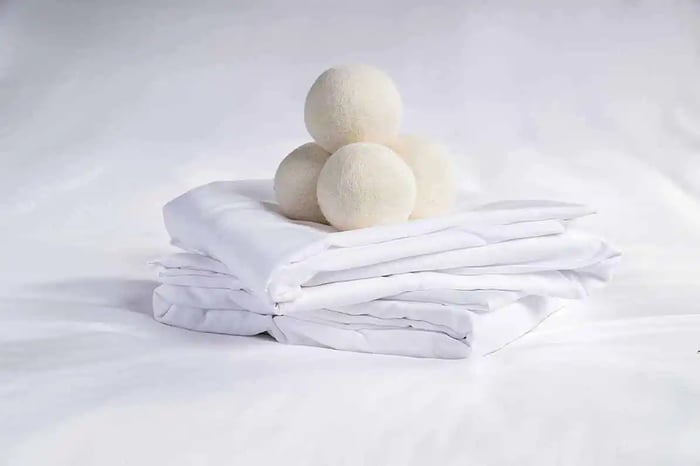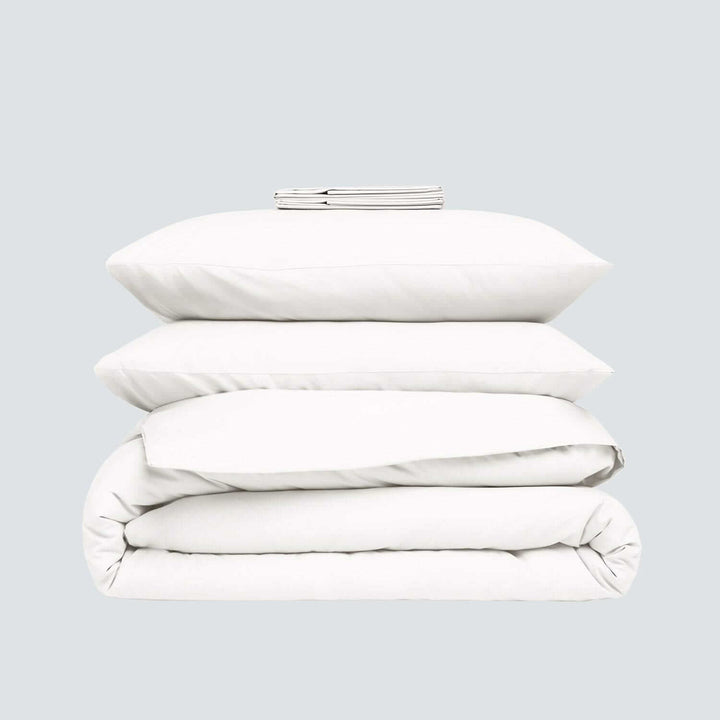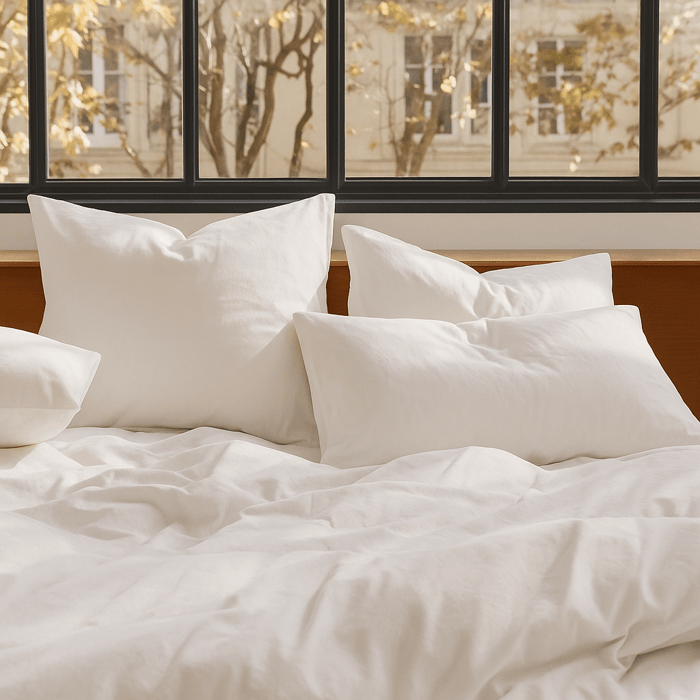Table of Contents
- The Thread Count Trap
- What Makes Bedding Truly Breathable
- The Science of Temperature Regulation During Sleep
- Why Natural Materials Outperform Synthetics
- The Role of Moisture Management
- How to Build a Cooler Sleep Environment
- A New Definition of Luxury
- Breathable Bedding vs. High Thread Count: The Comparison
- Why Wool Comforters Are Ideal for Hot Sleepers
- Sustainability and Regeneration: Cooling for the Planet Too
- Cooler Nights, Brighter Mornings
- FAQs on Wool Duvet Inserts, Comforters & Sustainable Bedding
If you’re a hot sleeper who wakes up sweaty and restless, you’re not alone. Millions of people search for breathable bedding, cooling comforters, and temperature-regulating duvets—often chasing a higher thread count, thinking it equals quality.
But here’s the truth: breathability beats thread count every time.
A silky 1,000-thread-count sheet might sound luxurious, but that dense weave locks in heat and moisture. For people prone to overheating, it’s the fast lane to sticky, sleepless nights. True comfort doesn’t come from the number of threads — it comes from airflow, moisture management, and natural insulation that works with your body, not against it.
At Antipodean Home, we craft bedding that helps your body breathe — using regenerative New Zealand wool and organic cotton to restore the balance between you, your sleep, and the natural world.

Natural comfort, refined. Breathable bedding with regenerative wool and organic cotton keeps your sleep cool, dry, and naturally balanced.
The Thread Count Trap
Thread count became a marketing myth. It was once a sign of craftsmanship, but now it’s often inflated or irrelevant. Here’s why:
More threads = less airflow. The higher the count, the tighter the weave — and the harder it is for air to move.
Tighter weaves trap heat. That “luxury hotel” feel might seem smooth, but it keeps warmth and humidity sealed in.
Natural fibers outperform synthetic blends. Cotton and wool breathe naturally, while polyester or microfiber trap heat.
The best sheets for hot sleepers usually fall between 300 – 400 thread count — the sweet spot for softness and breathability. Beyond that, you’re not buying comfort; you’re buying a sauna.
What Makes Bedding Truly Breathable
Breathable bedding isn’t just fabric — it’s a full-body climate system. When designed properly, it:
Regulates temperature by allowing excess warmth to escape.
Manages moisture through capillary wicking that keeps skin dry.
Promotes deeper sleep by maintaining a consistent micro-climate around your body.
Materials matter most. New Zealand wool and organic cotton both feature natural air pockets that draw heat and humidity away. Wool even absorbs up to 30 % of its weight in moisture without feeling damp — a game-changer for night sweats.
If you’re looking for the best bedding for hot sleepers, prioritize breathable natural fibers and lightweight fills. Synthetic “cooling” comforters often rely on chemical coatings that fade over time, while nature’s fibers keep performing night after night.
Regenerative Organic Cotton Sheet Set – Soft, Breathable & Sustainable

$189.00
Softer Sheets. Cleaner Sleep. Our organic cotton sheet set are simply better for the earth, and for your sleep. Grown on low-impact regenerative farms that actively heal the soil, our cotton is then woven and finished responsibly. This process eliminates… Read more
The Science of Temperature Regulation During Sleep
Your body follows a circadian rhythm, naturally lowering its core temperature by 1–2 °F as you fall asleep. When bedding prevents that drop, you’ll toss and turn.
Wool’s secret is its crimped fiber structure, forming millions of microscopic air pockets. These act like tiny thermostats — insulating when cool and venting when warm. That’s why a wool comforter for hot sleepers feels comfortable across seasons.
Meanwhile, organic cotton sheets enhance that effect at the surface. Their breathable weave absorbs perspiration, allowing it to evaporate quickly. Combined, they create a responsive system that adapts in real time to body temperature — something no synthetic comforter can replicate.
Breathability supports your body’s natural temperature regulation, helping your heart rate slow, your breathing steady, and your sleep cycles deepen. In short: better airflow = better REM sleep.
Why Natural Materials Outperform Synthetics
| Material | Breathability | Moisture Wicking | Temperature Regulation | Sustainability |
|---|---|---|---|---|
| Wool (Regenerative) | Excellent | Excellent | Excellent | 100 % renewable |
| Organic Cotton | High | Good | Moderate | Certified Organic |
| Bamboo Viscose | Moderate | Good | Moderate | Chemically processed |
| Polyester / Microfiber | Poor | Poor | Poor | Petrochemical |
Synthetic “performance” fabrics promise cooling comfort, but they can’t breathe. They block airflow and trap humidity against your skin.
By contrast, regenerative wool and organic cotton are thermo-adaptive — they respond to your body’s heat. Wool’s lanolin coating even resists odor and bacteria, keeping your bedding fresher longer. That’s sustainable luxury — comfort without compromise.
Sustainable & Regenerative Bedding Bundle | No More Night Sweats, Just Deeper Sleep

$598.40
$748.00
Cooler Nights & Deeper Sleep — Every Night Elevate your sleep with the only sustainable bundle crafted from regenerative New Zealand wool and organic cotton for true all-season comfort. These breathable, eco-friendly fibers naturally wick away heat and moisture to… Read more
The Role of Moisture Management
Overheating isn’t just about temperature — it’s about moisture. When sweat can’t evaporate, humidity builds up, and your body keeps working to cool down.
That’s where moisture-wicking comforters shine. Wool fibers absorb vapor before it turns into liquid sweat, moving it away from your body so you stay comfortably dry. Unlike synthetic “cooling gel” fabrics that simply feel cold to the touch, wool regulates heat and moisture continuously through the night.
Hot sleepers often report that switching to breathable wool bedding reduces night sweats, stabilizes temperature, and even shortens the time it takes to fall asleep.
How to Build a Cooler Sleep Environment
If you’re struggling with hot nights, think beyond the sheet set. A cooler sleep space starts with layering and airflow:
Choose natural fillings. Look for a cooling comforter made with organic or regenerative wool — light, airy, and moisture-balancing.
Pair with breathable cotton. A 300-count organic cotton sheet set complements wool perfectly.
Avoid heavy synthetics. Ditch polyester duvets and microfiber sheets that trap heat.
Let your bed breathe. Skip thick mattress protectors or memory foam toppers without ventilation.
Adjust your bedroom climate. Maintain 60–67 °F and let air circulate naturally.
This combination of materials and temperature balance supports your body’s own thermoregulation — creating the ideal cooling sleep sanctuary.
A New Definition of Luxury
Luxury isn’t a number on a label. It’s the feeling of waking naturally rested — your body cool, your mind clear, your bedding working quietly in the background.
True luxury begins with integrity:
Responsibly sourced materials from regenerative New Zealand farms.
Organic integrity free from toxins and microplastics.
Natural insulation that adapts to your sleep cycle.
Hand-finished craftsmanship that lasts for years, not seasons.
Our comforters and sheet sets are made with regenerative wool and GOTS-certified organic cotton, helping restore soil health and sequester carbon while you sleep. It’s bedding that breathes — for you and the planet.
Organic Wool Duvet Insert & Bedding Set | Sustainable & Regenerative | Made in New Zealand

$475.15
$559.00
Cooler Nights & Deeper Sleep — All Year Long Looking for the perfect organic wool duvet insert and wool bedding set? This complete bundle includes both the duvet insert and cover. (The insert uses the same breathable, temperature-regulating design as… Read more
Breathable Bedding vs. High Thread Count: The Comparison
| Feature | Breathable Bedding | High-Thread-Count Sheets |
|---|---|---|
| Airflow | Excellent | Restricted |
| Moisture Control | Natural wicking | Traps moisture |
| Temperature Balance | Adaptive | Overheats easily |
| Comfort Level | Lightweight & cool | Heavy & clammy |
| Longevity | Durable fibers | Weaken over time |
| Sustainability | Renewable materials | Often synthetic blends |
When you touch breathable bedding, you can feel the difference — a soft texture that lets air circulate rather than smother. That’s what makes a cooling comforter so effective for hot sleepers: continuous, gentle ventilation rather than short-term “cool-touch” gimmicks.
Why Wool Comforters Are Ideal for Hot Sleepers
A wool comforter isn’t just warm; it’s remarkably cool when you need it to be. The same properties that protect sheep from harsh climates keep humans perfectly balanced.
Temperature-responsive: adjusts to both cold and heat.
Lightweight: less bulk, more breathability.
Moisture-balancing: absorbs vapor before sweat forms.
Naturally hypoallergenic: resistant to mold, mildew, and dust mites.
Sustainably produced: renewable, biodegradable, and regenerative.
Unlike down or synthetic fills that either overheat or suffocate airflow, wool’s crimped structure keeps your duvet insert breathable, providing year-round comfort for every type of sleeper.
Sustainability and Regeneration: Cooling for the Planet Too
Cooling comfort doesn’t have to come at the planet’s expense. Regenerative farming — the source of our New Zealand wool — rebuilds soil health, increases biodiversity, and captures carbon naturally.
Every regenerative wool comforter supports farms that nurture the land instead of depleting it. That means every cool night’s sleep also contributes to a cooler planet.
It’s comfort with conscience: sleep well, live lightly, restore what’s been depleted.
Cooler Nights, Brighter Mornings
Breathability is the silent superpower behind restorative sleep. When your bedding allows air and moisture to move freely, your body can relax, repair, and reset.
So next time you shop, don’t get distracted by numbers. Feel the weave. Look for natural, breathable bedding made with organic or regenerative fibers. Choose comfort that works with your body — and wakes you up brighter.
Because when your bedding breathes, so do you. See how our regenerative wool and organic cotton bedding takes breathability to the next level.
FAQs on Wool Duvet Inserts, Comforters & Sustainable Bedding
Why do high-thread-count sheets feel hotter?
Because the weave is tighter, reducing ventilation and airflow — heat and moisture get trapped.
What’s the ideal thread count for breathable sheets?
Between 300 – 400 threads. It balances softness with ventilation for optimal comfort.
Are wool comforters really cooling?
Yes. Wool naturally regulates temperature, keeping hot sleepers cool and dry throughout the night.
What’s the best bedding material for hot sleepers?
A combination of organic cotton sheets and a lightweight wool comforter or duvet insert made with breathable, moisture-wicking fill.
How can I reduce night sweats naturally?
Choose breathable bedding (wool and organic cotton), maintain a cool room temperature, and avoid synthetics that trap heat.
What’s the difference between cooling comforters and synthetic ones?
Synthetic “cooling” fabrics rely on chemical treatments. Wool and organic cotton rely on physics — real airflow and temperature regulation.




